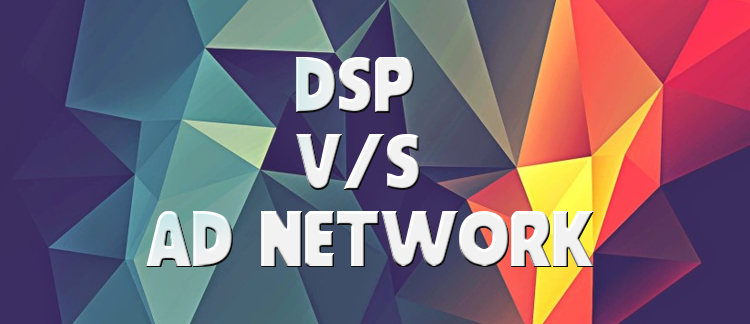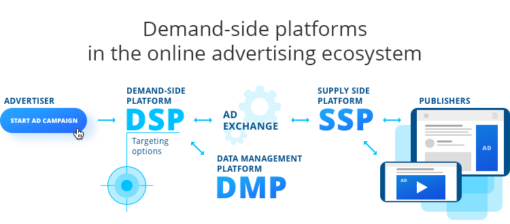
On the ever-changing landscape of digital advertising, there are many ways to buy traffic online. Among them, there are ad networks and demand-side platforms. Both of them serve one important goal of providing access to online inventory. However, there is a difference in how they help media buyers reach their intended audience online.
Since the 1990s, ad networks have been operating as middlemen between websites that wanted to monetize their inventory and advertisers that are looking to promote their products and services online. At the end of the 2000s, programmatic companies appeared on the horizon. As a result, demand-side platforms or DSPs evolved and became the main competitors of ad networks.
In this article, we overview DSPs and ad networks and compare how their strengths and weaknesses to help you decide which one is better for your media buying.
Demand-Side Platform 101
The demand-side platform is an automated technology that allows the buying of online impressions from multiple traffic providers in real time. It’s a platform where users promote their offers (services, products, goods, etc.) through setting up ad campaigns, driving new leads and measuring performance.
For media buyers, the demand-side platform is a point to reach hundreds of traffic sources like desktop and mobile websites, mobile apps, SSPs and ad exchanges. With only one DSP in a toolbox, the media buyer can reach the targeted audience through millions of screens at a time.
Most of the DSPs (Epom Market DSP, MediaMath, Reklamstore, etc) are self-serve platforms. That means that from the moment of signing up and until the daily report tracking the user has full control of what is happening in the DSP account.
Even though it may sound complicated, the DSP is built in a way to simplify media buying. It has extensive capabilities like audience targeting, automated optimization and real-time reports.
For example, the Epom Market team developed the so-called Bidding Autopilot feature. As its name suggests, the Bidding Autopilot takes traffic bidding under its full control. So the platform optimizes performance and automatically lowers the bid for specific traffic sources if they don’t achieve set ad goals (or moves these publishers to the blacklist).
Actually, this is how the DSP works; if you want to put something to work – just click on it.
The DSP creates the perfect setting for running multiple ad campaigns simultaneously and cuts down the human-factor aspect. The platform needs milliseconds to deliver the impression and to display results of the ad performance on a private dashboard.

The main benefits of DSPs
- The highest level of automation
The demand-side platform automates most processes that media buyers are dealing with. There are plenty of one-click options like mass copypasting, connecting to specific SSPs, retargeting, report downloading, etc.
The best part of it is that the DSP automates everyday optimization. This feature saves media buyers from babysitting daily analytics. The platform defines the best-performing traffic sources and gives them a higher priority while blacklisting publishers with bad results.
2. Cost-effective online advertising
When buying traffic within a DSP, media buyers set a bid that they can afford to pay. Then the DSP takes this bid and offers it to publishers, SSPs and ad exchanges. The DSP purchases the impression that ideally matches the media buyers requirements. As demand-side platforms have real-time bidding technology integrated, everything happens in real time.
With this approach, media buyers don’t overpay for the traffic while simultaneously getting cheaper inventory without losses in their KPIs.
Although most DSPs integrate third-party data providers to empower businesses with insights into their audience. DSPs offer extended targeting features, like the age, interests, and other details about users.
3. Consolidation of media buys
Along with a DSP account, the users also get a technology (ad server), the audience, performance tracking tools, protection against fraud and many more vital things. The DSP only needs your creatives and your budgets. Some DSPs provide functionality for designing your ad units also. For example, the Epom Market DSP supports branding and designing native ads from top to bottom.
4. Ad performance tracking
The start of a new era in programmatic required more ad performance metrics to be tracked. And DSPs successfully adapted new challenges. Today many DSP accounts allow media buyers to monitor conversions, ad viewability, retention rate and other metrics to measure ad campaign effectiveness.
In fact, no matter how many ad campaigns you have active in your DSP account. DSP brings together tones of real-time data about ad campaigns performance. When displayed in one place, analytics may expose gaps in marketing strategies, as well as suggest further steps on your way to a higher ROI.
5. Cross-device ad campaigns
The DSP is a tool for running an unlimited number of multiscreen ad campaigns at a time. With only one DSP, media buyers may acquire mobile impressions, reach desktop screens and launch video creatives simultaneously.
Having all your cross-device ad campaigns in one place helps to understand, which creatives work better and which ones have to be excluded. DSPs have many more outstanding features to make your programmatic media buying more effective.
5 key things to know about DSPs
For whom are DSPs? For advertisers and media buyers.
Onboarding Time: Signing up takes a few minutes.
Pricing: The media buyer has control over bids, the price is directly proportioned to the quality of the traffic
Transparency: 100% transparent.
Optimization: Automated; handled and maintained by the platform.
Advertising Network 101
Since the 1990s, ad networks have been matching advertisers who want to promote their goods or services with the right audience through ads on specific websites.
Along with access to multiple websites, ad networks also offer media buyers the technology. Every ad network uses an ad server, one of the key elements that make online advertising possible. When the media buyer signs up to a specific ad network, it provides him/her with two things. The first is access to the online inventory and the second is an account for tracking numbers and the results of ad activities.
When advertising with an ad network, the media buyer is able to view stats or put ad campaigns on hold (not always). And the process of ad campaign set up, connecting to particular publishers, everyday optimization is done by the manager who stays behind the ad network.
Unlike DSPs, ad networks have a lot of room for human work. When media buyers sign up for an account, they are assigned to the ad network’s manager. The manager is the one who takes the creatives and campaign details and then sets everything up on the ad networks side.
This approach has both advantages and shortcomings. With ad networks, the media buyer doesn’t invest much time in the technical setup or everyday optimization as everything is already done for him (or her). But, of course, these services are not free. Usually, ad networks take a high margin and media buyers aren’t aware of how much they pay to the middleman and how much they give for the traffic.
With ad networks, a lot of things stay blurred. For example, users of ad networks rarely have enough luck to see names of publishers that send traffic to their ad campaigns. And they also don’t know how much the traffic really costs.
Nevertheless, advertising with ad networks still has its benefits for media buyers.

The main benefits of ad networks
1. An option of paying for clicks and conversions
While DSPs sell traffic for fixed bids, many ad networks have the option of paying for conversions, installs or clicks. In this way, media buyers may secure their budgets from underperforming traffic. For example, Leadbolt ad network offers two types of accounts – for CPM/CPC ad campaigns and for CPI advertising.
2. Access to top-quality and niche publishers
There are different types of ad networks. For example, topic-specific ad networks sell traffic for particular kinds of offers such as business-oriented ads, automotive ads, or even fashion ads. Inventory-specific networks focus on mobile, desktop, video or native advertising. If someone wants to place ads on popular websites with millions of daily visitors, the publisher will probably forward you to a partner premium ad network. Affiliate networks are the best fit for affiliate activities and performance ad campaigns.
The world’s top publishers like the CNN or HuffPost level don’t trust their inventory to SSPs or ad exchanges. They also don’t sell it directly to advertisers. This is why ad networks are the only way to reach premium inventory. Although ad networks help smaller or niche publishers monetize their impressions.
3. Save time on setup and daily optimization
Yet again, ad networks are irreplaceable when it comes to time-efficient media buying. If the media buyer doesn’t want to bother with the setup or optimization of ad campaigns, ad network teams may help with this for sure.
5 key things to know about ad networks
For whom? For publishers and advertisers
Onboarding Time: From a few minutes to a couple of days, it usually depends on the response rate of a specific network.
Pricing: Usually fixed CPM prices regardless of the quality of the inventory.
CPC, CPI, and CPA payment options are also available
Transparency: Lower than 100%. Blurred reports
Optimization: Required, usually manual, but also automated.
——-
All in all, both DSPs and ad networks are must-try media buying options for businesses that want to grow online. Please share in comments which one delivered better results to your ad campaigns!
Sign up to Epom Market DSP to leverage your media buying with a self-serve DSP or trust your media buying to ad network professionals.
Great read, exactly what I was looking for to increase my knowledge in the programmatic space. Kudos!